Researchers at the Large Hadron Collider believe they may have identified the elusive “God particle”
Researchers at the Large Hadron Collider (LHC) believe they’ve identified the Higgs boson, the most sought after prize in particle physics.
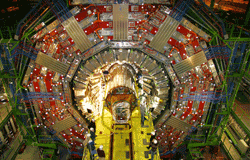
The Large Hadron Collider in Geneva. (Credit: boston.com)
If you’re unfamiliar with the Higgs boson and LHC, here are five things to know to help you follow this developing story:
1. The Standard Model and the Higgs boson
The Standard Model is, essentially, an instructional booklet that describes how subatomic particles and forces interact. It’s made up of 16 particles total: 12 matter particles and four force-carrier particles.
It’s worked fairly well in the world of physics so far, but there are some issues that researchers need to resolve in order to attain a more complete understanding of the Universe. For one, the Standard Model cannot explain one of the most fundamental forces out there — gravity. Also, it describes only ordinary matter which, in the big picture of things, makes up just a small portion of the total Universe (dark matter is much more dominant). Then, there’s the Higgs boson issue.
The Higgs boson, or “God particle,” is based upon a theory first proposed in 1964 by physicists Peter Higgs, Francois Englert, and Robert Brout. In it, they stated that particles acquire mass through their interactions with an all-pervading field, called the Higgs field, and are carried by the Higgs boson. In other words, the Higgs boson is responsible for everything in the Universe obtaining mass. Identifying it is important to the Standard Model because it would explain why other elementary particles (except photon and gluon) have mass. Particle masses, and the differences between electromagnetism and weak force, are significant to many aspects of the structure of microscopic, and thus macroscopic, matter.
2. The LHC — in a nutshell
The LHC was built by the European Organization for Nuclear Research in order to test high-energy physics theories like the Higgs boson. It took more than 15 years to build, with over 10,000 scientists from 40+ countries contributing to the effort.
It is, essentially, a “Big Bang Machine.” The LHC is a Super Proton Synchrotron built in a tunnel roughly 12.5 feet in diameter that stretches 17 miles in circumference. It lies several hundred feet below the France-Switzerland border near Geneva, Switzerland.

The Large Hadron Collider underground beam line. (Credit: physicsworld.com)
The LHC collides two counter rotating beams of subatomic particles (protons) or lead ions at 99.9999999% the speed of light, in conditions colder than the space between the stars. By crashing them together, researchers are able to study the subsequent release of unstable, high-energy particles.

An example of proton-proton collision. (Credit: nsf.gov)
3. Record speeds
The proton beams move around the LHC ring inside continuous vacuum chambers. In order to get them traveling fast enough, scientists and engineers generate a powerful magnetic field using 1,740 superconducting magnetics, which needed approximately 40,000 leak-tight welds and 65,000 splices of specially designed superconducting cables.
In order to avoid excessive resistive losses, the magnets are kept at just a few degrees above absolute zero. This is achieved using an enormous, incredibly intricate cryogenics system: eight above-ground refrigeration plants which, altogether, pump approximately 400,000 liters of liquid helium a year.
4. Enormous detectors
The LHC proton beams can be stored at high energy for 10 to 20 hours. Over the course of 10 hours, they’ll make four hundred million revolutions, with collisions taking place inside LHC experiment zones, or detectors. These detectors are capable of pinpointing a particle with an accuracy of 15 microns; that’s 20 times thinner than a piece of your hair.
There are six detectors total. They’re all housed in strategically located, underground caverns. Two — the ATLAS experiment and Compact Muon Solenoid (CMS) — are large, general purpose detectors, while A Large Ion Collider Experiment (ALICE) and LHCb have more specific roles. The other two, TOTEM and LHCf, are smaller and set up for very specific research.
A summary and pictures of the four main detectors:
• ATLAS
Looks for signs of new physics, including origins of mass and extra dimensions.
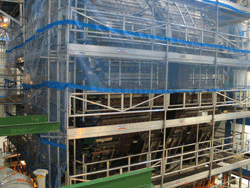
ATLAS detector at the Large Hadron Collider. (Credit: lhc.web.cern.ch/lhc/)
• CMS
Hunts for the Higgs boson and look for clues to the nature of dark matter.
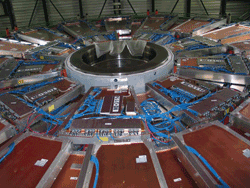
CMS detector at the Large Hadron Collider. (Credit: lhc.web.cern.ch/lhc/)
• ALICE
Studies a “fluid” form of matter called quark-gluon plasma that existed shortly after the Big Bang.
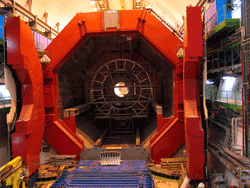
ALICE detector at the Large Hadron Collider. (Credit: lhc.web.cern.ch/lhc/)
• LHCb
Equal amounts of matter and antimatter were created in the Big Bang the LHCb investigates what happened to the “missing” antimatter.
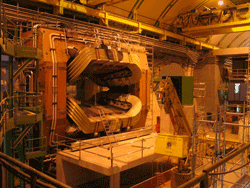
LHCb detector at the Large Hadron Collider. (Credit: lhc.web.cern.ch/lhc/)
5. Putting it all together
Due to their enormity, detectors were assembled in bits. ATLAS was lowered in pieces over several years, and assembled almost entirely underground. When its largest part — the barrel toroid magnet — had to be brought down a shaft, it had just 10 cm of clearance. And that’s just the heavy lifting! There was also all of the fine engineering work that needed to be done in order to actually assemble these detectors. Layers of electronic sensors were wired and connected by hand, with up to 300 people a day working in the cave up against one another.
Meanwhile, the CMS was assembled mostly above ground in units, including the world’s largest-ever electromagnet. It took 10 hours to be lowered down a 330-foot shaft, with a clearance of just 20 cm on either side. Adding to the stress of this endeavor was the fact that its cylindrically arranged silicon wafer detectors contain a vast network of micro-circuitry including 73,000 radiation-hard, low-noise microelectronic chips, 40,000 analog optical links, and 1,000 power supply units. One wrong move and the detector could suffer some fairly severe damage.
So what did the LHC researchers see?
At a seminar yesterday, the heads of ATLAS and CMS said that they saw “spikes” in their data at roughly the same mass: 124-125 gigaelectronvolts (GeV). Guido Tonelli, spokesperson for the CMS detector, summarized the state of the experiment: “The excess is most compatible with a Standard Model Higgs in the vicinity of 124 GeV and below, but the statistical significance is not large enough to say anything conclusive.
As of today, what we see is consistent either with a background fluctuation or with the presence of the boson.”
Further complicating the validity of this story is that these stats come from just a few events among the billions of particle collisions that get analyzed at the LHC. The team will need many more events to occur in order to lend some credence to this claim.
Regardless though, the possibility that the Higgs boson might have been discovered has generated a ton of excitement in the world of science and engineering. ■
References for this story:
Advertisement
Learn more about Electronic Products Magazine





